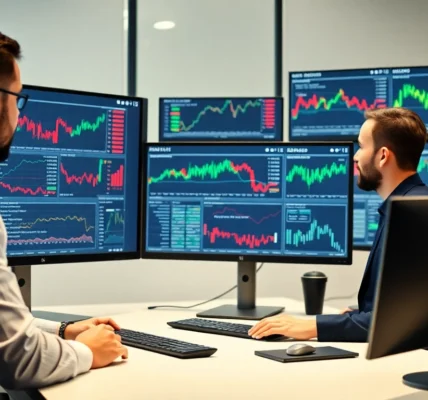Introduction to Trading View and Its Core Features
In today’s fast-paced financial markets, access to accurate and real-time data is essential for successful trading and investing. As a result, platforms like trading view have become indispensable tools for traders of all experience levels. Trading View stands out as a comprehensive web-based charting and social networking platform that not only provides advanced technical analysis tools but also fosters a vibrant community of market enthusiasts. Its versatility across multiple asset classes—stocks, cryptocurrencies, forex, commodities, and more—makes it a go-to solution for anyone aiming to make informed trading decisions.
Overview of Key Tools and Functionalities
Trading View offers an extensive suite of tools tailored to enhance market analysis and decision-making. Among its core features are:
- Advanced Charting: Users can access hundreds of chart types, overlays, and drawing tools to analyze market movements visually.
- Technical Indicators: A vast library of indicators—including moving averages, RSI, MACD, Bollinger Bands, and custom scripts—allows for detailed analysis.
- Multi-Timeframe Analysis: Ability to view charts across various timeframes, from minutes to monthly, enabling traders to understand both short-term and long-term trends.
- Screeners and Watchlists: Customizable tools to filter assets based on technical and fundamental criteria, enhancing the efficiency of market scans.
- Alerts & Notifications: Personalized alerts trigger when specific price levels or indicator signals are met, ensuring timely actions.
- Community & Social Trading: Users share ideas, publish analysis, and discuss market insights, fostering collaborative learning.
- Multi-Device Compatibility: Seamless access across web, desktop, and mobile applications ensures traders are connected wherever they are.
Understanding Market Charts and Indicators
Market charts are the backbone of technical analysis. Trading View’s interactive charts allow traders to visualize price movements over selected periods, leveraging a suite of tools and indicators to interpret emerging patterns. Recognizing trendlines, support and resistance levels, and chart formations like head and shoulders or flags is simplified with drawing tools and overlays.
Indicators complement these visual analyses. For instance, moving averages smooth out price data to identify trend direction, while oscillators like RSI help spot overbought or oversold conditions. Combining multiple indicators can validate signals and reduce false positives, thereby increasing confidence in trade entries and exits.
Moreover, the platform’s ability to share and embed charts enhances collaborative analysis, allowing traders to learn from each other’s insights and refine their strategies continually.
How to Use Trading View for Effective Trading Strategies
Mapping Market Trends with Trading View Charts
Effective trading starts with understanding the broader market context. Trading View’s charts help map trends by utilizing tools like trendlines, channels, and pattern recognition. Traders often identify uptrends with higher highs and higher lows, or downtrends with lower lows and lower highs, to determine the prevailing market direction.
For instance, a trader might use Fibonacci retracement levels within Trading View to identify potential support zones during a pullback, increasing the probability of a successful bounce or breakout.
Setting Alerts and Notifications for Better Timing
Timing is critical in trading. Trading View’s alert system allows users to set notifications based on price movements, indicator conditions, or drawing tool levels. This proactive approach means traders don’t need to constantly monitor the screen, reducing emotional decision-making and ensuring they act promptly when market conditions meet their predefined criteria.
Examples include alerts for crossing moving average lines, breakout of resistance levels, or divergence signals from oscillators, all of which can significantly improve trade execution quality.
Integrating Trading View with Other Trading Platforms
While Trading View offers rich analytical features, effective traders often integrate it with brokerage accounts or trading platforms. Many brokers support direct execution from Trading View, enabling traders to transition seamlessly from analysis to execution.
Integration also allows for data synchronization, consolidated portfolio tracking, and streamlined workflows—ultimately enhancing trading efficiency and accuracy.
Advanced Techniques for Professional Traders
Customizing Indicators and Scripts
One of Trading View’s most powerful features is its Pine Script language, enabling users to create custom indicators and automate strategies. Professional traders tailor scripts to fit specific trading styles, backtest strategies, and generate unique signals that are not available out-of-the-box.
Analyzing Multiple Markets Simultaneously
Trading View’s multi-chart layout feature allows traders to monitor several assets concurrently. This is especially useful for arbitrage opportunities or relative strength analysis across markets. Synchronizing scales and timeframes helps traders spot divergences or correlations that inform more sophisticated trading decisions.
Backtesting and Performance Metrics
Backtesting is vital for validating strategies before risking real capital. Trading View offers a built-in backtesting environment where traders can simulate trades based on historical data, analyze performance metrics like win rate, profit factor, and drawdowns, and fine-tune their strategies accordingly.
Optimizing User Experience and Engagement
Personalizing Your Watchlists and Layouts
Efficiency is key. Users can customize watchlists to track favorite assets and organize layouts with different chart types, indicators, or timeframes tailored to specific trading styles. Saving these configurations streamlines workflow and enhances focus.
Using Social Features to Share and Gather Ideas
Community engagement elevates trading skills. Trading View’s social features enable users to publish ideas, comment, and collaborate on market analysis. This exchange of insights fosters continuous learning and can provide fresh perspectives or early signals from other experienced traders.
Mobile and Desktop Compatibility Tips
Maximizing the platform’s potential requires familiarity with its multi-device capabilities. The mobile app offers real-time alerts, quick charting, and seamless sync with desktop layouts. Desktop versions provide powerful analysis tools and scripting options, ideal for in-depth review. Ensuring synchronization across devices guarantees a consistent trading experience.
Maximizing Results: Best Practices & Future Trends
Staying Updated with Trading View Innovations
Trading View continually updates its features, integrating AI-driven analysis, enhanced scripting options, and more. Regularly exploring new functionalities or participating in platform beta tests can provide a competitive edge and keep traders aligned with evolving market dynamics.
Data-Driven Decision Making and Risk Management
Using quantitative tools and performance metrics, traders can develop systematic strategies that minimize emotional biases. Proper risk management—setting stop-losses, position sizes, and exit strategies—must be integrated with technical insights for sustainable success.
Case Studies of Successful Trading Strategies
For example, swing traders utilizing support and resistance levels identified on Trading View, combined with momentum indicators like RSI, have achieved consistent results by aligning entries with broader trend analysis. Reviewing such cases enhances practical understanding and inspires refined approaches.




